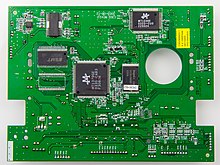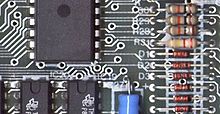
Back Gedrukte stroombaan Afrikaans لوحة دارة مطبوعة Arabic Circuitu impresu AST Sxem lövhəsi Azerbaijani Друкаваная плята BE-X-OLD Печатна платка Bulgarian প্রিন্টেড সার্কিট বোর্ড Bengali/Bangla Štampana ploča BS Circuit imprès Catalan Plošný spoj Czech


A printed circuit board (PCB), also called printed wiring board (PWB), is a laminated sandwich structure of conductive and insulating layers, each with a pattern of traces, planes and other features (similar to wires on a flat surface) etched from one or more sheet layers of copper laminated onto or between sheet layers of a non-conductive substrate.[1] PCBs are used to connect or "wire" components to one another in an electronic circuit. Electrical components may be fixed to conductive pads on the outer layers, generally by soldering, which both electrically connects and mechanically fastens the components to the board. Another manufacturing process adds vias, metal-lined drilled holes that enable electrical interconnections between conductive layers, to boards with more than a single side.
Printed circuit boards are used in nearly all electronic products today. Alternatives to PCBs include wire wrap and point-to-point construction, both once popular but now rarely used. PCBs require additional design effort to lay out the circuit, but manufacturing and assembly can be automated. Electronic design automation software is available to do much of the work of layout. Mass-producing circuits with PCBs is cheaper and faster than with other wiring methods, as components are mounted and wired in one operation. Large numbers of PCBs can be fabricated at the same time, and the layout has to be done only once. PCBs can also be made manually in small quantities, with reduced benefits.[2]
PCBs can be single-sided (one copper layer), double-sided (two copper layers on both sides of one substrate layer), or multi-layer (stacked layers of substrate with copper plating sandwiched between each and on the outside layers). Multi-layer PCBs provide much higher component density, because circuit traces on the inner layers would otherwise take up surface space between components. The rise in popularity of multilayer PCBs with more than two, and especially with more than four, copper planes was concurrent with the adoption of surface-mount technology. However, multilayer PCBs make repair, analysis, and field modification of circuits much more difficult and usually impractical.
The world market for bare PCBs exceeded US$60.2 billion in 2014,[3] and was estimated at $80.33 billion in 2024, forecast to be $96.57 billion for 2029, growing at 4.87% per annum.[4]
- ^ "What Is a Printed Circuit Board (PCB)? - Technical Articles". AllAboutCircuits.com. Retrieved June 24, 2021.
- ^ Bhunia, Swarup; Tehranipoor, Mark (2019). "Chapter 2, section 2.6, A Quick Overview of Electronic Hardware". Hardware Security. p. 36. doi:10.1016/b978-0-12-812477-2.00007-1. ISBN 978-0-12-812477-2.
- ^ "World PCB Production in 2014 Estimated at $60.2B". iconnect007. September 28, 2015. Retrieved April 12, 2016.
- ^ "PCB Market Size". PCB Market Size, Share, Trends. Retrieved December 22, 2024.